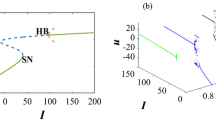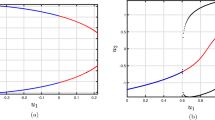Abstract
The Hodgkin–Huxley model1 of the nerve impulse consists of four coupled nonlinear differential equations, six functions and seven constants. Because of the complexity of these equations and the necessity for numerical solution, it is difficult to use them in simulations of interactions in small neural networks. Thus, it would be useful to have a second-order differential equation which predicted correctly properties such as the frequency–current relationship. Fitzhugh2 introduced a second-order model of the nerve impulse, but his equations predict an action potential duration which is similar to the inter-spike interval3 and they do not give a reasonable frequency–current relationship. To develop a second-order model having few parameters but which does not have these disadvantages, we have generalized the second-order Fitzhugh equations2, and based the form of the functions in the new equations on voltage-clamp data obtained from a snail neurone. We report here an unexpected property of the resulting equations—the x and y null clines in the phase plane lie close together when the phase point is on the recovery side of the phase plane. The resulting slow movement along the phase path gives a long inter-spike interval, a property not shown clearly by previous models2,4. The model also predicts the linearity of the frequency–current relationship, and may be useful for studying detailed interactions in networks containing small numbers of neurones.
This is a preview of subscription content, access via your institution
Access options
Subscribe to this journal
Receive 51 print issues and online access
$199.00 per year
only $3.90 per issue
Buy this article
- Purchase on Springer Link
- Instant access to full article PDF
Prices may be subject to local taxes which are calculated during checkout
Similar content being viewed by others
References
Hodgkin, A. L. & Huxley, A. F. J. Physiol., Lond. 117, 500–554 (1952).
Fitzhugh, R. Biophys. J. 1, 445–466 (1961).
Jack, J. J. B., Noble, D. & Tsien, R. W. (eds) Electric Current Flow in Excitable Cells, 330 (Clarendon, Oxford, 1975).
Kokoz, Yu M. & Krinskii, V. J. Biofizika 18, 878–885 (1973).
Frank, K. & Tauc, L. in Cellular Function of Membrane Transport (ed. Hoffman, J.) 113–134 (Prentice-Hall, New Jersey, 1964).
Connor, J. A. & Stevens, C. F. J. Physiol., Lond. 213, 31–53 (1971).
Wilson, W. A. & Goldner, M. M. J. Neurobiol. 6, 411–422 (1975).
Merson, R. H. in Proc. of Symp. on Data Processing (Weapons Research Establishment, South Australia, 1957).
Author information
Authors and Affiliations
Rights and permissions
About this article
Cite this article
Hindmarsh, J., Rose, R. A model of the nerve impulse using two first-order differential equations. Nature 296, 162–164 (1982). https://doi.org/10.1038/296162a0
Received:
Accepted:
Issue Date:
DOI: https://doi.org/10.1038/296162a0
This article is cited by
-
Dynamics analysis and hardware implementation of multi-scroll hyperchaotic hidden attractors based on locally active memristive Hopfield neural network
Nonlinear Dynamics (2024)
-
Soliton-like nonlinear excitation in the FitzHugh–Nagumo cardiac model through the cubic–quintic complex Ginzburg–Landau equation
Nonlinear Dynamics (2024)
-
Hopfield neural network with multi-scroll attractors and application in image encryption
Multimedia Tools and Applications (2024)
-
Energy evolution in function neuronal network under different coupling channels
Nonlinear Dynamics (2024)
-
Dynamical effects of memristive electromagnetic induction on a 2D Wilson neuron model
Cognitive Neurodynamics (2024)
Comments
By submitting a comment you agree to abide by our Terms and Community Guidelines. If you find something abusive or that does not comply with our terms or guidelines please flag it as inappropriate.



